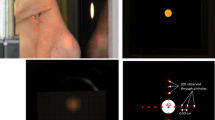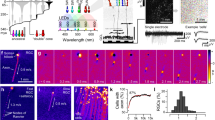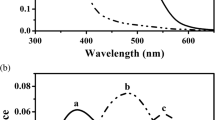Summary
-
1.
Receptor potentials have been recorded intracellularly from single retinular cells in the anterior and dorsal quadrants of the compound eye of the crayfish Procambarus (Fig. 1) stimulated with equal quantum flashes of linearly polarized monochromatic light. Comparisons between two orthogonal stimulus e-vectors respectively parallel and perpendicular to the microvilli of each receptor cell's rhabdomere were made sequentially in about one minute's running time at 20 nm intervals between 400 and 740 nm (Fig. 2).
-
2.
Of the 91 cells studied 17 responded maximally in the violet (av. λ max= 440 nm) whereas the other 74 cells were most responsive in the yellow-orange (av.λ max=594 nm) (Table 1). For the latter group the λ max of individual cells ranged widely from 538 to 634 nm (Fig. 4). Violet sensitive cells were found only in the anterior quadrant of the eye.
-
3.
For 29 cells spectral sensitivity curves were plotted from the spectral efficiency curves using response-energy functions determined at λ max or spectral efficiency curves taken at two or more stimulus energy levels (Figs. 5B, 6B, 7). When the sensitivity curves are normalized the vertical and horizontal e-vector responses are closely similar indicating that dichroism of the visual pigment is undoubtedly responsible for the observed differential sensitivity (Figs. 5C, 6C).
-
4.
For 51 yellow-orange cells where e-vector comparisons can be made more than half (57%) were more responsive to vertical e-vector (Table 2) corresponding very closely with the estimated percentage of retinular cells with microvilli parallel to the body's dorso-ventral axis (57.2%). In contrast five of the seven violet cells available for this comparison gave stronger responses to horizontal e-vector suggesting they may predominantly be the one asymmetrical cell in each ommatidium. Nevertheless both color discriminating types were found to be present in both e-vector channels.
-
5.
For the 29 cells for which spectral sensitivity curves can be plotted the average sensitivity ratio for the two polarization planes is 3.1 with a range from 1.2 to 11.9 at λ max. Since dichroic absorption ratios directly measured in crayfish have previously been shown to be about 2, the origin of greater spectral sensitivity ratios in individual retinular cells most likely must depend on other functions than photon absorption by a single rhabdomere.
Similar content being viewed by others
References
Autrum, H., Kolb, G.: Spektrale Empfindlichkeit einzelner Sehzellen der Aeschniden. Z. vergl. Physiol. 60, 450–477 (1968).
—, Zwehl, V. von: Die Sehzellen der Insekten als Analysatoren für polarisiertes Licht. Z. vergl. Physiol. 46, 1–7 (1962).
—: Die spektrale Empfindlichkeit einzelner Sehzellen des Bienenauges. Z. vergl. Physiol. 48, 357–384 (1964).
Bäuerlein, R.: Morphophysiologische Untersuchungen zum Sehvermögen von Potamon potamios rhodium Parisi (Decapoda, Potamonidae). Forma et Functio 1, 285–331 (1969).
Bennett, R.: Spectral sensitivity studies on the whirligig beetle, Dineutes ciliatus. J. Insect Physiol. 13, 621–633 (1967).
Bennett, R. R., Tunstall, J., Horridge, G. A.: Spectral sensitivity of single retinular cells of the locust. Z. vergl. Physiol. 55, 195–206 (1967).
Bernhard, C. G. (ed.): The functional organization of the compound eye. pp. 591. Oxford: Pergamon Press 1966.
Bernhards, H.: Der Bau des Komplexauges von Astacus fluviatilis (Potamobius astacns L.). Z. wiss Zool. 116, 649–707 (1916).
Bruckmoser, P.: Die spektrale Empfindlichkeit einzelner Sehzellen des Rückenschwimmers Notonecta glauca L. (Heteroptera). Z. vergl. Physiol. 59, 187–204 (1968).
Burkhardt, D.: Spectral sensitivity and other response characteristics of single visual cells in the arthropod eye. Symp. Soc. exp. Biol. 16, 86–109 (1962).
—, Wendler, L.: Ein direkter Beweis für die Fähigkeit einzelner Sehzellen des Insektenauges, die Schwingungsrichtung polarisierten Lichtes zu analysieren. Z. vergl. Physiol. 43, 687–692 (1960).
Dartnall, H. J. A.: The interpretation of spectral sensitivity curves. Brit. med. Bull. 9, 24–30 (1953).
Eguchi, E.: Rhabdom structure and receptor potentials in single crayfish retinular cells. J. cell. comp. Physiol. 66, 411–429 (1965).
—, Waterman, T. H.: Cellular basis for polarized light perception in the spider crab, Libinia. Z. Zellforsch. 84, 87–101 (1968).
Fernández, H. R.: A survey of the visual pigments of decapod Crustacea of South Florida, 133 pp. Thesis, University of Miami, Coral Gables, Florida 1965.
Genest, A.: An analysis of dark adaptation in two crustacean forms, Callinectes sapidus and Procambarus sp., 64 pp. Thesis, Yale University, New Haven, Connecticut 1961.
Giulio, L.: Elektroretinographische Beweisführung dichroitischer Eigenschaften des Komplexauges bei Zweiflüglern. Z. vergl. Physiol. 46, 491–495 (1963).
Glantz, R. M.: Light adaptation in the photoreceptor of the crayfish, Procambarus clarkii. Vision Res. 8, 1407–1421 (1968).
Goldsmith, T. H.: The visual system of insects. In: The physiology of insecta, vol. I, (M. Rockstein, ed.), p. 397–462. New York: Academic Press 1964.
—: Do flies have a red receptor? J. gen. Physiol. 49, 265–287 (1965).
—: The natural history of invertebrate visual pigments. In: Handbook of sensory physiology, vol. VII. The photochemistry of vision (H. J. A. Dartnall, ed.). Berlin-Heidelberg-NewYork: Springer 1970 (in press).
—, Fernández, H. R.: Comparative studies of crustacean spectral sensitivity. Z. vergl. Physiol. 60, 156–175 (1968).
Hagins, W. A., Liebman, P. A.: The relationship between photochemical and electrical processes in living squid photoreceptors. Abstracts of Biophysical Society 7th Annual Meeting, New York, N.Y. ME 6. 1963.
Harreveld, A. D. van: A physiological solution for freshwater crustaceans. Proc. Soc. exp. Biol. Med. (N.Y.) 34, 428–432 (1936).
Hays, D., Goldsmith, T. H.: Microspectrophotometry of the visual pigment of the spider crab Libinia emarginata. Z. vergl. Physiol. 65, 218–232 (1969).
Horridge, G. A.: Perception of polarization plane, colour and movement in two dimensions by the crab, Carcinus. Z. vergl. Physiol. 55, 207–224 (1967).
—: Unit studies on the retina of dragonflies. Z. vergl. Physiol. 62, 1–37 (1969).
Kaneko, A., Hashimoto, H.: Recording site of the single cone response determined by an electrode marking technique. Vision Res. 7, 847–851 (1967).
Kennedy, D., Bruno, M. S.: The spectral sensitivity of crayfish and lobster vision. J. gen. Physiol. 44, 1089–1102 (1961).
—, Selverston, A. I., Remler, M. P.: Analysis of restricted neural networks. Science 164, 1488–1496 (1969).
Kuwabara, M., Naka, K.: Response of a single retinula cell to polarized light. Nature (Lond.) 184, 455–456 (1959).
Langer, H.: Nachweis dichroitischer Absorption des Sehfarbstoffes in den Rhabdomeren des Insektenauges. Z. vergl. Physiol. 51, 258–263 (1965).
—: Grundlagen der Wahrnehmung von Wellenlänge und Schwingungsebene des Lichtes. Verh. dtsch. zool. Ges. Göttingen 30, 195–233 (1966).
Langer, H., Thorell, B.: Microspectrophotometry of single rhabdomeres in the insect eye Exp. Cell Res. 41, 673–677 (1966a).
—: Microspectrophotometric assay of visual pigments in single rhabdomeres of the insect eye. In: The functional organization of the compound eye (C. G. Bernhard, ed.), p. 145–150. Oxford: Pergamon Press 1966b.
Liebmann, P. A.: In situ microspectrophotometric studies on the pigments of single retinal rods. Biophys. J. 2, 161–178 (1962).
Lüdtke, H.: Dunkeladaptation und Verschiebung der Helligkeitswerte im Auge von Notonecta glauca L. Z. Naturforsch. 9, 159–163 (1954).
Mazokhin-Porshniakov, G. A.: Colorimetric study of color vision in the dragonfly. Biofizika 4, 427–436 [in Russian]. Biophysics 4, 46–57 (English translation) (1959).
Moody, M. F.: Photoreceptor organelles in animals. Biol. Rev. 39, 43–86 (1964).
Nosaki, H.: Electrophysiological study of color encoding in the compound eye of crayfish, Procambarus clarkii. Z. vergl. Physiol. 64, 318–323 (1969).
Parker, G. H.: The retina and optic ganglia in decapods, especially Astacus. Mitteil. Zool. Station Neapel 12, 1–73 (1895).
Ruck, P.: The components of the visual system of a dragonfly. J. gen. Physiol. 49, 289–307 (1965).
Rutherford, D. J., Horridge, G. A.: The rhabdom of the lobster eye. Quart. J. micr. Sci. 106, 119–130 (1965).
Schneider, L., Langer, H.: Die Struktur des Rhabdoms im „Doppelauge“ des Wasserläufers Gerris lacustris. Z. Zellforsch. 99, 538–559 (1969).
Shaw, S. R.: Polarized light responses from crab retinula cells. Nature (Lond.) 211, 92–93 (1966).
—: Simultaneous recordings from two cells in the locust retina. Z. vergl. Physiol. 55, 183–194 (1967).
—: Organization of the locust retina. Symp. Zool. Soc. (Lond.) 23, 135–163 (1968).
—: Interreceptor coupling in ommatidia of drone honeybee and locust compound eyes. Vision Res. 9 (9), 999–1029 (1969a).
—: Sense-cell structure and interspecies comparisons of polarized light absorption in arthropod compound eyes. Vision Res. 9 (9), 1031–1040 (1969b).
Stieve, H.: Die spektrale Empfindlichkeitskurve des Auges von Eupagurus bernhardus L. Z. vergl. Physiol. 43, 518–525 (1960).
Tomita, T., Kaneko, A., Murakami, M., Pautler, E. L.: Spectral response curves of single cones in the carp. Vision Res. 7, 519–531 (1967).
Wald, G.: Single and multiple visual systems in arthropods. J. gen. Physiol. 51, 125–156 (1968).
—, Brown, P. K., Gibbons, I. R.: Visual excitation: a chemoanatomical study. Symp. Soc. exp. Biol. 16, 32–57 (1962).
—, Seldin, E. B.: Spectral sensitivity of the common prawn Palaemonetes vulgaris. J. gen. Physiol. 51, 694–700 (1968).
Waterman, T. H.: Light sensitivity and vision. In: The physiology of Crustacea, vol. II (T. H. Waterman, ed.), p. 1–64. New York: Academic Press 1961.
—: Information channeling in the crustacean retina. In: Proc. of the Symp. on Information Processing in Sight Sensory Systems, (P. W. Nye, ed.), p. 48–56. Pasadena: National Institutes of Health and the California Institute of Technology 1966.
Waterman, T. H.: Systems theory and biology — view of a biologist. In: Systems theory and biology (M. D. Mesarović, ed.), p. 1–37. Berlin-Heidelberg-New York: Springer 1968.
—, Fernández, H. R., Goldsmith, T. H.: Dichroism of photosensitive pigments in rhabdoms of the crayfish Orconectes. J. gen. Physiol. 54, 415–432 (1969).
—, Horch, K. W.: Mechanism of polarized light perception. Science 154, 467–475 (1966).
Author information
Authors and Affiliations
Additional information
These experiments were carried out in the Laboratory of Professor Tsuneo Tomita, Department of Physiology, Keio University School of Medicine. A preliminary report on this work was made at the December, 1969 meeting of the American Society of Zoologists.
We are grateful to Professor Tsuneo Tomita and his associates in the Department of Physiology, School of Medicine, Keio University, Tokyo for their hospitality, unfailing help and advice in carrying out these experiments. Dr. Hiroshi Nosaki generously made available to us his earlier experience with this preparation. Thanks are also due Mrs. Mabelita Campbell for her helpful assistance.
Rights and permissions
About this article
Cite this article
Waterman, T.H., Fernández, H.R. E-Vector and wavelength discrimination by retinular cells of the crayfish Procambarus . Z. Vergl. Physiol. 68, 154–174 (1970). https://doi.org/10.1007/BF00297692
Received:
Issue Date:
DOI: https://doi.org/10.1007/BF00297692




